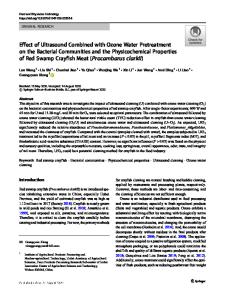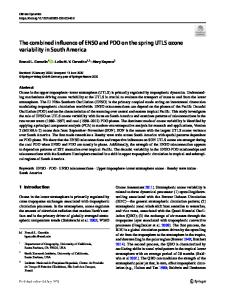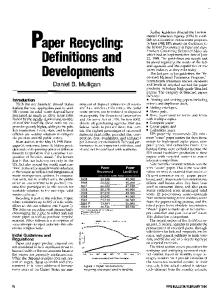Effects and Mechanisms of Alkali Recycling and Ozone Recycling on Enzymatic Conversion in Alkali Combined with Ozone Pre
- PDF / 727,911 Bytes
- 15 Pages / 439.37 x 666.142 pts Page_size
- 72 Downloads / 314 Views
Effects and Mechanisms of Alkali Recycling and Ozone Recycling on Enzymatic Conversion in Alkali Combined with Ozone Pretreatment of Corn Stover Zhezhen Zhao 1 & Jiaming Zhang 1
1
& Yiming Li & Fei Li
1
& Ping Liu
1
Received: 5 July 2020 / Accepted: 11 September 2020/ # Springer Science+Business Media, LLC, part of Springer Nature 2020
Abstract
In order to minimize waste liquor, save resources, and reduce costs, the effects of alkali recycling and ozone recycling on enzymatic conversion in alkali combined with ozone pretreatment of corn stover and the mechanism were studied. The results showed that as the number of cycles of alkali/ozone filtrate increased, the enzymatic conversion and the loss of reducing sugars showed a downward trend. It was indicated that the ability of alkali to damage lignocellulosic decreased with an increasing number of alkali circulation and the accumulation of lignin degradation products generated during ozonolysis inhibited enzymatic conversion. When the ozone filtrate was recovered and used for hydrolysis directly, the enzymatic conversion rates were basically the same compared with the first self-circulation of ozone filtrate, and no sewage was discharged. In conclusion, the optimal circulating pretreatment was four times alkali circulation and ozone filtrate was used as an enzymolysis liquid directly, and the conversion rates of cellulose and hemicellulose were 85.96% and 34.26%, respectively, saving 44% alkali consumption at the same time. This paper provided the theoretical basis for the development of lignocellulose pretreatment technology with low cost, high efficiency, and high conversion rate. Keywords Lignocellulose . Alkali combined with ozone pretreatment . Circulating pretreatment . Enzymatic conversion rate . Loss of reducing sugar . Corn stover
Introduction Lignocellulosic biomass is the most abundant and bio-renewable resource, which is composed of three principal polymers: cellulose (35 to 40%), hemicellulose (20 to 40%), and lignin (15 to 35%) [1, 2]. The cellulose and hemicellulose can be hydrolyzed into fermentable sugars, which
* Ping Liu [email protected] Extended author information available on the last page of the article
Applied Biochemistry and Biotechnology
can further be fermented to ethanol [3, 4]. Blending ethanol in a certain proportion with gasoline can be used as fuel ethanol [5]. The cellulose and hemicelluloses of lignocellulose are linked to the lignin by covalent bonds, and cellulose is framed by its highly crystalline ordered structure, hindering the biodegradation of lignocelluloses [6]. The enzymatic hydrolysis rate of lignocellulosic biomass without any pretreatment may be less than 20%, while the enzymatic hydrolysis rate can be increased to 90% after proper pretreatment [7]. Therefore, an ideal pretreatment process is needed to destroy the structure of lignocellulose and make it easy to be hydrolyzed [8–10]. However, some pretreatment methods in the previous studies require high-temperature or high-pressure conditions, so it is mea
Data Loading...











